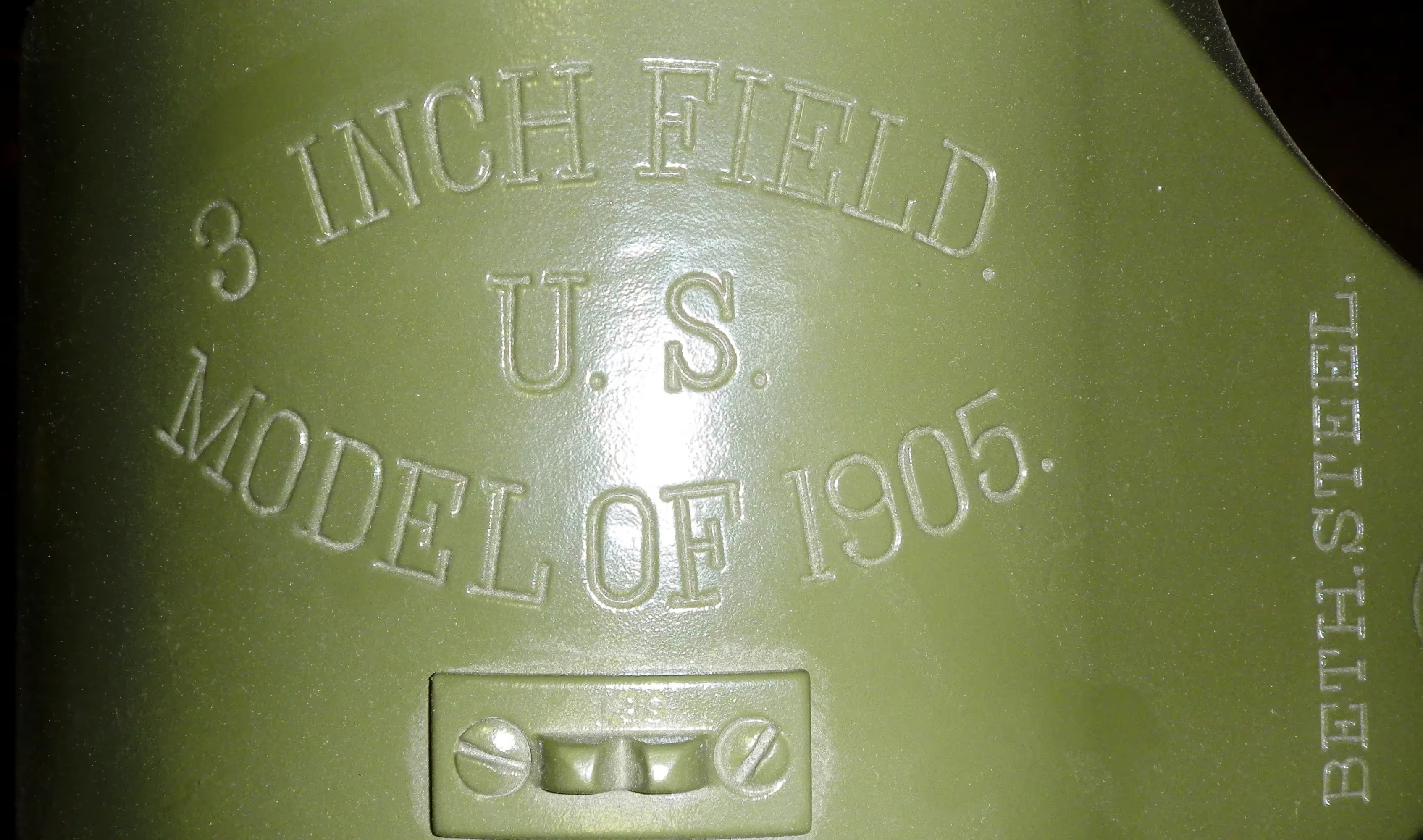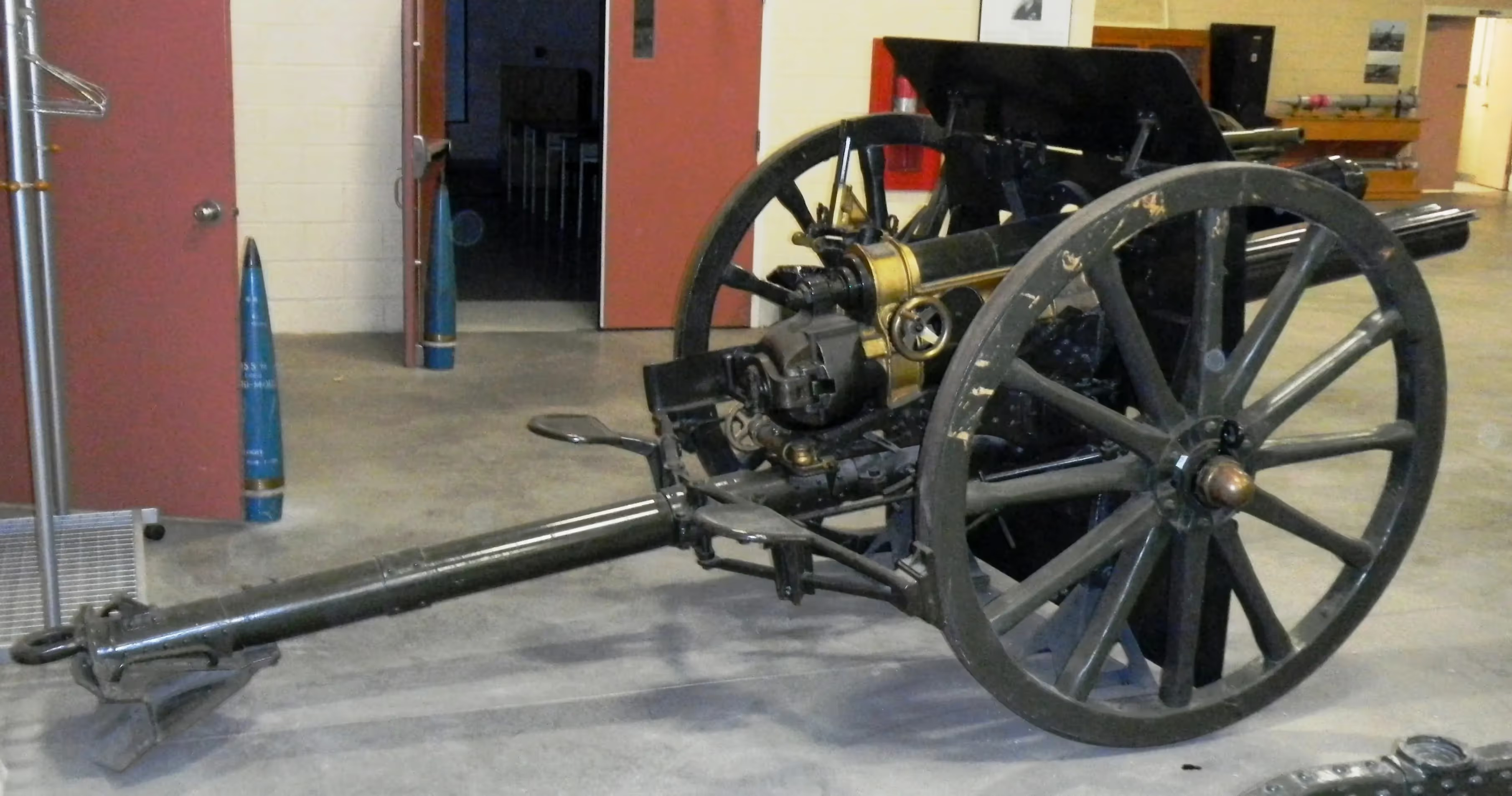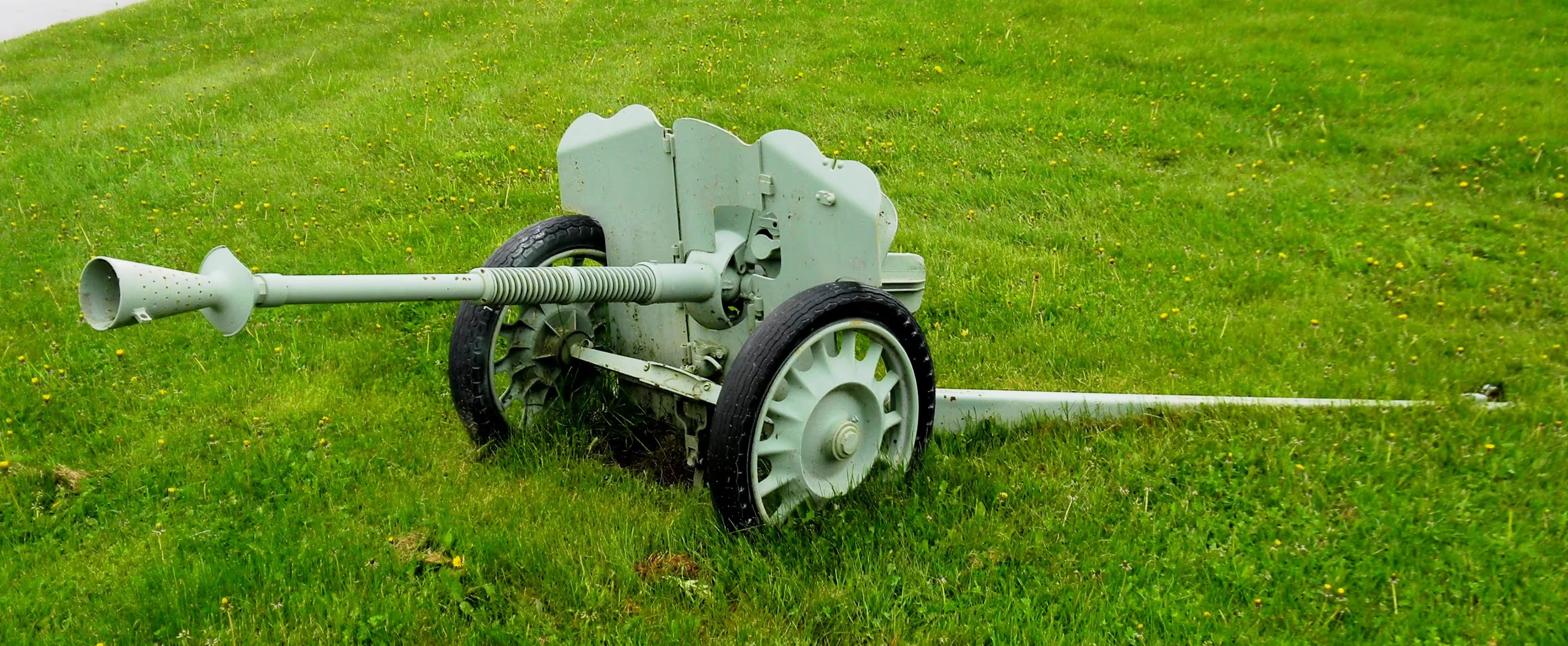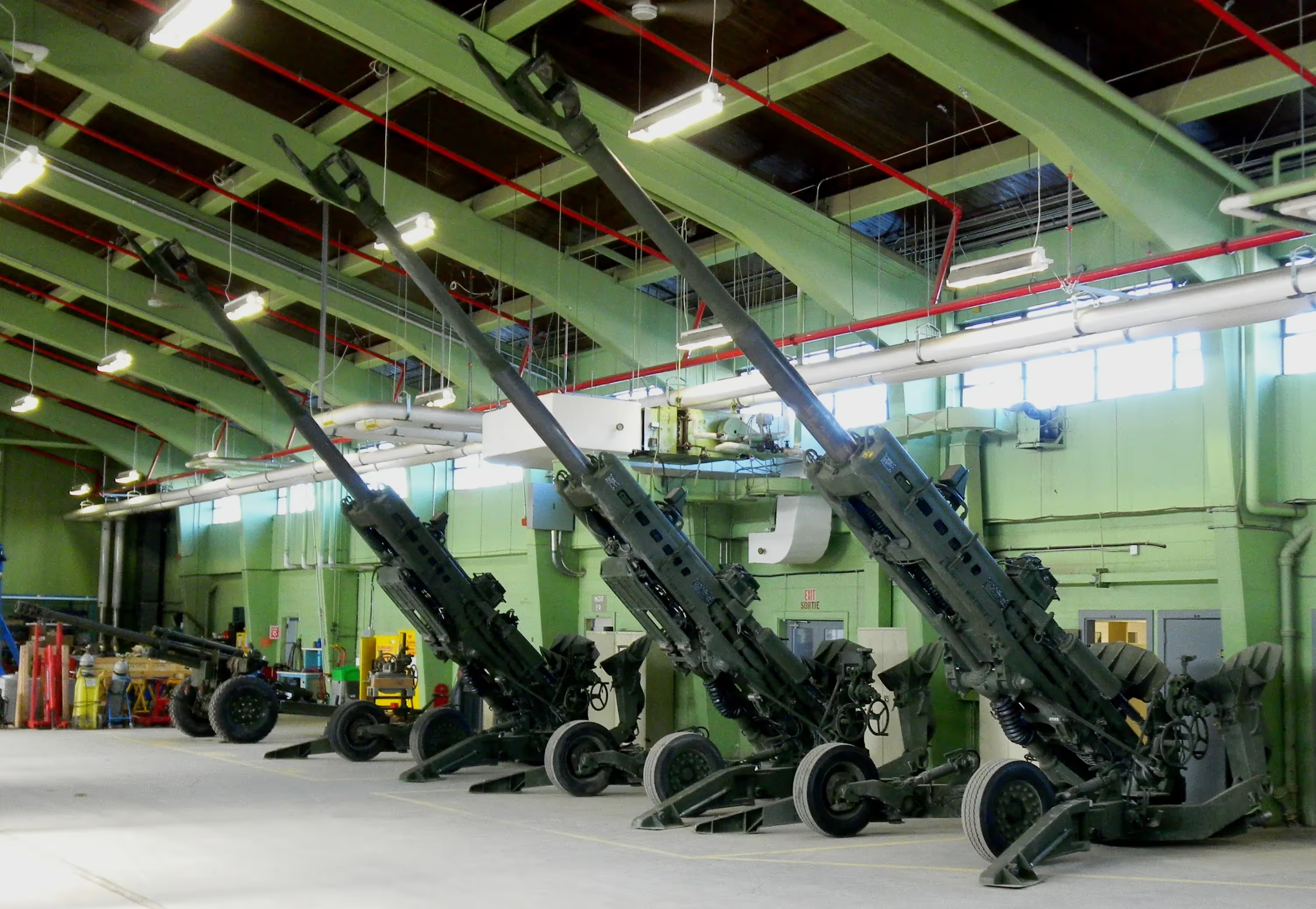Artillery in Canada (7) New Brunswick: 5 Canadian Division Support Base (5 CDSB) Gagetown, Royal Regiment of Canadian Artillery School (RRCAS)
Artillery preserved in New Brunswick, 5 Canadian Division Support Base Gagetown, Royal Regiment of Canadian Artillery School (RRCAS)
Artillerie préservée au Nouveau-Brunswick, Base de soutien de la 5 Division du Canada à Gagetown, École du Royal Regiment of Canadian Artillery (RRCAS)

18-pounder Field Gun, silver presentation sculpture, RRCAS, 5 CDSB Gagetown.
The aim of this web page is to locate, identify and document every historical piece of artillery preserved in the RRCAS as 5 CDSB Gagetown. Many contributors have assisted in the hunt for these guns to provide and update the data found on these web pages. Photos are by the author unless otherwise credited. Any errors found here are by the author, and any additions, corrections or amendments to this list of Guns and Artillery in Canada would be most welcome and may be e-mailed to the author at [email protected].
For all official data concerning the Royal Regiment of Canadian Artillery, please click on the link to their website:
Royal Regiment of Canadian Artillery Website
Note: Back in the day, artillery in Canada was referred to by its radio call sign "Sheldrake". It is now referred to by its "Golf" call sign. (Acorn sends)
Le but de cette page Web est de localiser, d'identifier et de documenter chaque pièce d'artillerie historique conservée dans le RRCAS
sous le nom de 5 CDSB Gagetown. De nombreux contributeurs ont aidé à la recherche de ces armes à feu pour fournir et mettre à jour
les données trouvées sur ces pages Web. Les photos sont de l'auteur, sauf indication contraire. Toutes les erreurs trouvées ici sont de
l'auteur, et tout ajout, correction ou amendement à cette liste d'armes à feu et d'artillerie au Canada serait le bienvenu et peut être envoyé
par courriel à l'auteur à [email protected].
Une traduction au français pour l'information technique présente serait grandement apprécié. Vos corrections, changements et suggestions sont les bienvenus, et peuvent être envoyés au [email protected].

Royal Regiment of Canadian Artillery School (RRCS)

(CF Photo)
155-mm M777 in action, RCRCS at 5 Canadian Division Support Base Gagetown.

(DND Photo)

(DND Photo)


Cast Iron 2-1/4-pounder Smoothbore Muzzleloading Falconet, weight unknown, mounted on a wood carriage, inside the school. This gun was loaned by the Lockhart family, Bath New Brunswick, to BGen Moncel, HQ, 3rd Canadian Infantry Brigade, Camp Gagetown, 2 July 1959. Presented to the Artillery School by LCol J.D.E. Crossman, 13 Aug 1978, and restored in 2004. Building J7.
.avif)
.avif)
.avif)










12-pounder 6-cwt Breechloading Mk. IV Gun, weight 6-0-9 (681 lbs), made by Armstrong, mounted on a wheeled carriage, Queen Victoria cypher, inside the school. No. 136, RGF 1898, 12 pdr 6 cwt on right trunnion. RCD 1910 on right wheel hub, RCD 1896 on left wheel hub as well as 628470. No. 20 on the carriage box trail. 1307024 on the breech.
Three of these guns were recorded as on strength in with 90 Field Battery, Fredericton in 1933: Reg. No. 285, RGF 01, carriage OCM; RGF No. 286, carriage OCM; and Reg. No. 200, RGF 01, carriage OCM).





U.S. Model 1905 3-inch field gun, (Serial No. 309), built by Bethlehem Steel, 1914. This gun is one of 477 produced by three different makers prior to the First World War. The gun is mounted on a Model 1902 field carriage (Serial No. 548), built by Rock Island Arsenal, 1917. It is accompanied by a Model 1916 Limber. This gun was presented to the Royal Regiment of Canadian School (RCAS) by the United States Army Artillery and Missile School, 7 November 1961.


Limber (Serial No. 1890), 3-inch Gun Caisson, Model of 1916, Rock Island Arsenal, 1918. This limber was made in Illinois. The Rock Island Arsenal was the traditional builder of U.S. Army field carriages, limbers, and caissons. The number of Model 1902 carriages built exceeds that of the Model 1905, because the Models 1902, 1904, and 1905 3-inch guns were all mounted on the Model 1902 field carriage. In 1918 the year the First World War ended, the U.S. Army was still being provided with 3-inch ordnance matériel, whereas the American units sent overseas used only French 75-mm Guns.






American 75-mm M1917 Field Gun, Bethlehem Steel Coy, 1912, 995 Pounds, (Serial No. 489) on the muzzle. This gun is mounted on a 75-mm Gun Carriage Model of 1917 (British), Bethlehem Steel Company, 1918, (Serial No. 2079), MMC, according to the builder's plate on the carriage. This gun is on loan from the Royal Canadian Artillery Museum. This is an American version of the British QF 18-pounder modified to fire French 75-mm ammunition. One other gun, an M1917A1, is preserved in the RCA Museum, CFB Shilo, Manitoba.
The U.S. Model 1917 shown here is the original horsedrawn type, designated the Model 1917 (or M1917). The one preserved with the RCA Museum at CFB Shilo has been "high-speeded" with Martin Parry gear and therefore is the M1917A1. Although most field artillery enthusiasts note the d muzzle (flush with the front of the recoil guides) of the American piece vis-à-vis its British counterpart, many miss the difference in the configuration of the splinter shield. The main shield (ignoring the top and bottom extensions) of the British gun (both 18-pounder and 13-pounder) is bent back at the level of the gun, whereas the main shield of the American gun is not, but is straight up and down (though tilted back a little from bottom to top). Finally, in the CFB Shilo gun’s description, mention is made of the Bethlehem Steel “Coy”. An American business firm or the American military unit whose size lies between the platoon and the battalion is ALWAYS abbreviated “Co.” NEVER “Coy.” The latter is for British and Commonwealth usage and should be corrected wherever American firms appear. (Nelson Lowry)
.avif)


.avif)
81-mm C3 Mortar, inside the RRCAS.


American 4.2-inch M-30 Mortar on M24 Mount, Rock Island Arsenal, 1952, inside the RRCAS.

(Library and Archives Canada Photo, MIKAN No. 3205726)
L/Bdr D. Robertson, Sgt W. Malcolm, Gunner R. Flemming and Gunner J. Gaudet (left to right), Royal Canadian Horse Artillery (RCHA), ready to fire 25-pounder, 26 Sep 1951.









25-pounder C Mk. 2 QF Field Gun with No. 9 circular firing platform, in front of the main entrance to the school.


25-pounder C Mk. 2 QF Field Gun with No. 9 circular firing platform, with funeral platform, inside the school.


Limber for 25-pounder C Mk. 2 QF Field Gun.




.avif)
.avif)
American 75-mm QF M1A1 Pack Howitzer (Serial No. 3063), on an M8 Carriage, Arsenal No. 5024, inside the school. This gun is on loan from the RCA Museum, CFB Shilo, Manitoba.





105-mm L5 Pack Howitzer, (Serial No. 57747), inside the school.

120-mm Mortar with wheeled flat base plate and 1941 Canadian tires, outside K lines.

French Hotchkiss 25-mm APX modèle 1937 or Canon de 25 mm semi-automatique modèle 1937 (canon de 25) anti-tank gun (Serial No. 2206), stamped APX 1940, G 25, SAL 1937. This gun was captured by the German Army c1940 during the Second World War. The Germans used a number of captured guns under the designation 2.5 cm Panzerabwehrkanone 113(f) (25 PstK/37). They were used to arm Atlantic Wall fortifications in France and the occupied Channel Islands. This gun was recaptured by the Allies, and is now on display outside the RRCAS’s K lines.
The 25 SA-L mle 1937 was a lengthened 77 caliber derivative of the 1934 version designed by the APX, with a much lighter 300 kg (660 lb) carriage. The barrel of the mle 1937 was 125-mm (5 in) longer than the mle 1934. The mle 1937 was designed and produced by Puteaux and it weighed 310 kg (680 lb). The mle 1937 was intended to be used by infantry units and towed by horses. The AT gun had a poor armour piercing performance of 40-mm (1.6 in) at 400 m (440 yd) and while easy to use, it was too lightly constructed to be durable.
At the outbreak of the Second World War, it was the main anti-tank weapon of the French infantry. By May 1940, there were reported to be 6,000 in service with the French Army. In action in the Battle of France in 1940, it was found that the projectile was too small to be very effective against German tanks, especially at longer ranges. It remained a useful weapon against armoured cars and other light armoured vehicles.


Russian 85-mm D-44 Divisional Gun, outside the school’s K lines.


Blowpipe short range surface to air missile launcher and Missile, inside the RRCAS.

Javelin short range surface to air missile launcher, inside the RRCAS.


105-mm C1A1 M2A2 Howitzer (Reg. No. 15062), outside the Artillery School’s K lines.

155-mm M109 Self-Propelled Howitzer, 1 RCHA, Fallex 1982, Germany. (Library and Archives Canada Photo, MIKAN No. 4876327)



155-mm M109 Self-Propelled Howitzer, (Reg. No. 77240), 1985, AC: NX, ECC: 119205 HUI C: 1760, SAUI C: 1760, VMO No. DLE21801, VMO. On display in front of the Royal Regiment of Canadian Artillery School.

105mm C2 (M101/33) Howitzers, inside the Artillery School’s K lines hangar.

105-mm LG1 Mk. II Howitzer, inside the K lines hangar, Royal Regiment of Canadian Artillery School (RCAS), 5 Canadian Division Support Base Gagetown, New Brunswick.

155-mm M777 Howitzers inside the K Line hangar of the Royal Regiment of Canadian Artillery School (RCAS), 5 Canadian Division Support Base Gagetown, New Brunswick.

Cessna L-19E Bird Dog (Serial No. 16733), Canadian Army, Royal Canadian Artillery Spotter aircraft in flight over CFB Gagetown, July 1973. (Photo courtesy of the Shearwater Aviation Museum)

155-mm M777 Gun Crew, Royal Regiment of Canadian Artillery School (RCAS), 5 Canadian Division Support Base Gagetown, New Brunswick, taking part in New Brunswick Day celebrations on the grounds of the Lieutenant-Governor of New Brunswick in Fredericton, 6 August 2012.

Canadian soldiers fire a 155mm M777 Howitzer from a forward operating base in the Helmand Province of Afghanistan, 7 April 2007. (U.S. Army photo by Spc. Keith D. Henning)





